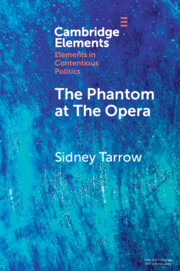Element contents
The Phantom at The Opera
Published online by Cambridge University Press: 22 December 2021
Summary
Keywords
- Type
- Element
- Information
- Series: Elements in Contentious PoliticsOnline ISBN: 9781009043731Publisher: Cambridge University PressPrint publication: 27 January 2022
References
- 2
- Cited by



